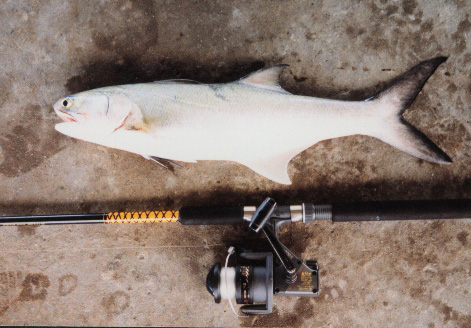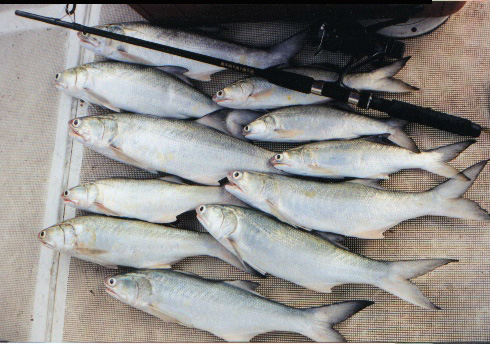|
Out of boredom, I decided to
try jigging for some kembung to see if I could land enough for
Assam Laksa for the following day's lunch. On the first cast, I had a
take. I was thinking the kembung must be really big for they gave a really
good struggle.
 When
they neared the surface, I was thrilled to find not kembung but three
big Threadfin Salmon (Senangin) attached to the bait jigs. Two
were in excess of 3 kgs! The fish must have seen my face and got a shock
for they made a sudden dash for freedom, both going the opposite direction!
Obviously, the line gave way and I only managed to land the small one
on the top hook which weighed 1 kg. When
they neared the surface, I was thrilled to find not kembung but three
big Threadfin Salmon (Senangin) attached to the bait jigs. Two
were in excess of 3 kgs! The fish must have seen my face and got a shock
for they made a sudden dash for freedom, both going the opposite direction!
Obviously, the line gave way and I only managed to land the small one
on the top hook which weighed 1 kg.
Disappointed but not beaten, I tied on a
new set of Sabiki fish skin jigs, this time with bigger hooks and thicker
line of 20lbs. The set of 6 hooks was divided into half as it would be
easier to handle 3 fish at a time. Upon seeing my fish landed, Uncle Thomas
also sprang into action.
 Each
cast with the jigs resulted in a positive hookup and the Threadfin gave
a tremendous account of themselves, running left and right and surging
down deep whenever the landing net was sighted. The sortie only lasted
half an hour and as quick as they arrived, they departed. Each
cast with the jigs resulted in a positive hookup and the Threadfin gave
a tremendous account of themselves, running left and right and surging
down deep whenever the landing net was sighted. The sortie only lasted
half an hour and as quick as they arrived, they departed.
In one memorable trip, my fishing buddy Aik
Pin and I had a ball catching these marvellous and expensive fish. We
were drifting above a wreck known to produce big Tripletooths but as soon
as the Threadfin arrived, the baits did not even have any chance to reach
the bottom. Every cast caught a fish and the final tally for that hour
was 11 Threadfin Salmon.
 Threadfin
Salmon are a gregarious schooling fish, taking baits with gusto. They
seem to be attracted to lumo beads found on bait jigs. This is probably
because they mistake these as little prawns and when a group of these
beads bounce up and down, they resemble a whole school of baitfish or
prawn swimming around, thus triggering an attack from the school. Baits
such as kembung (mackerel) fillets or prawns work well as well
when fished about 4 - 7 feet off the bottom. Threadfin
Salmon are a gregarious schooling fish, taking baits with gusto. They
seem to be attracted to lumo beads found on bait jigs. This is probably
because they mistake these as little prawns and when a group of these
beads bounce up and down, they resemble a whole school of baitfish or
prawn swimming around, thus triggering an attack from the school. Baits
such as kembung (mackerel) fillets or prawns work well as well
when fished about 4 - 7 feet off the bottom.
Threadfin are also found inshore in coastal
waters off sandy bottoms, hunting prawns, gelama, billis (anchovies)
or bulu (sand whiting). Rig up a bait with two 2/0 suicide hooks
on the back and cast out as far as possible. No wire is needed but a mono
leader of about 30lb is recommended to stand up to the abrasive mouth
of the fish.
Threadfin are top table fare and fetch a
high price in local markets. They are best steamed when fresh or cooked
in assam curry.
|

